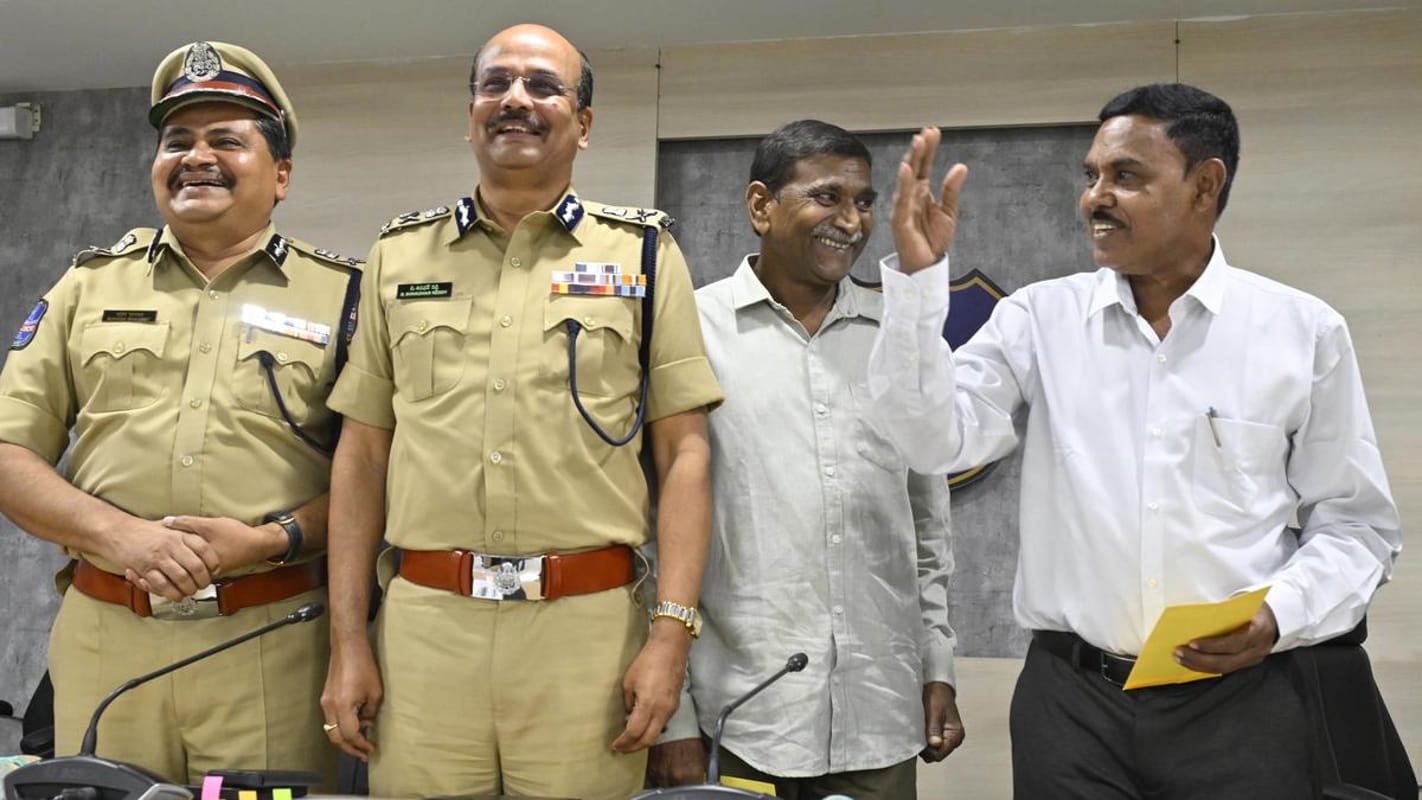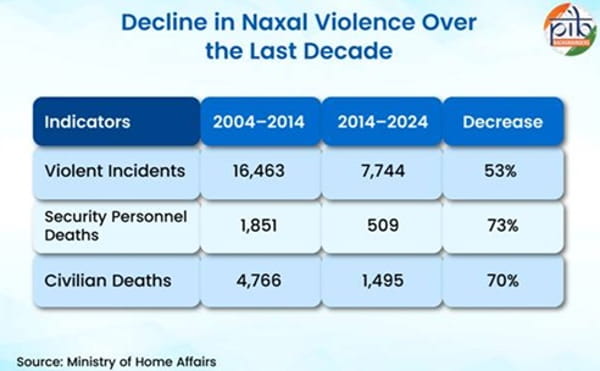
Senior-most Maoist leaders Bandi Prakash and Pulluri Prasad Rao surrender before Telangana Director General of Police B. Shivadhar Reddy, October 2025. | Nagara Gopal / The Hindu
India has proven that when intent is strong, policy is clear, and the public is supportive, no internal insurgency can sustain itself. India’s goal is now clear: a completely Naxal-free nation by March 2026, where trust will speak louder than guns, and development will bloom where terror once reigned.
Introduction
Have the Maoists been completely uprooted from states like Telangana, Jharkhand, Madhya Pradesh, Maharashtra, and Tamil Nadu, similar to what has been achieved in Central Bihar? Have the Government and security forces broken the backbone of Naxalite organisations to such an extent that a resurgence is now virtually impossible? Furthermore, has development and security infrastructure been established so robustly in the affected areas that no rebellious activity can take root again? These questions are being raised because the achievements India has recorded against Naxalism in the last decade are unprecedented.
Between 2014 and 2024, Naxal-related violent incidents saw a 53 percent decline. Fatalities among security personnel dropped by 73 percent, and civilian deaths decreased by 70 percent. By October 2025, 1,225 Naxals had surrendered and 270 had been neutralised. The situation in states once plagued by Naxal violence has completely transformed today. Telangana is a prime example, where 427 Maoist cadres have laid down their arms and chosen the path of the mainstream this year alone.
Senior Naxals resign
Senior According to Telangana Director General of Police B. Shivadhar Reddy, the surrendering cadres include several senior Maoist leaders. These include P. Prasad Rao alias Chandranna, who had been underground for 45 years, and Bandi Prakash alias Prabhath, who had been underground for 42 years. Both decided to leave the organisation, expressing faith in law and order and opting to return to the social mainstream. Prasad carried a reward of ₹25 lakh and Prakash ₹20 lakh, which the Telangana government handed over to them via demand drafts. Both are also receiving additional benefits under the state's rehabilitation policy.
The surrender of leaders like Prasad and Prakash is attributed not only to sustained security pressure but also to ideological differences, growing internal rifts within the organisation, and health issues. Prasad himself stated that it was "not a surrender, but a decision to join civil society." He asserted that he would now work for the people of Telangana and that a clear division had emerged within the Maoist movement: one faction favouring laying down arms, while the other supporting continued armed struggle.
March 2026: A Naxal-free India
Union Home Minister Amit Shah has announced that the government’s goal is to make the country Naxal-free by March 2026. Towards this end, the Centre has adopted a holistic and coordinated policy with three key elements: security, development, and rehabilitation. Fragmented responses of the past have been replaced by an integrated approach based on dialogue, coordination, and precise strategy.
This policy is anchored not merely by force of arms, but by a foundation of "trust and opportunity." Over the last decade, the number of Naxal-affected districts has reduced from 126 to just 18, with only six of these now classified as most-affected. The government has constructed 576 fortified police stations and established 336 new security camps in the last ten years. To make security operations faster and more effective, 68 night-landing helipads have been built, significantly improving response times during operations.
Utilising technological and financial tools
Modern technology has also played a crucial role in anti-Naxal operations. Security agencies are now utilising cutting-edge tools such as location tracking, mobile data analysis, call record examination, social media analysis, and AI-based data analytics. Drone surveillance and satellite imaging have made it easier to identify Naxal strongholds hidden deep in the forests. Operations like ‘Operation Black Forest’ and ‘Operation Kagar’ in 2024 resulted in the death or arrest of several top Naxal commanders.
The financial backbone of the Naxals has also been decisively attacked. The National Investigation Agency (NIA) seized assets worth over ₹40 crore, the Enforcement Directorate (ED) confiscated ₹12 crore, and states seized approximately ₹40 crore worth of property. The dismantling of this financial network has severely crippled the capacity of Naxal organisations for recruitment and arms procurement.
To empower state forces, the Centre released ₹3,331 crore under the Security Related Expenditure (SRE) scheme, an increase of 155 percent compared to the previous decade. Additionally, ₹991 crore was sanctioned under the Special Infrastructure Scheme (SIS) for the construction of fortified police stations. ₹3,769 crore was dedicated to development works in Naxal-affected districts under the Special Central Assistance (SCA).

Development is the best policy
Development has been the most effective pillar of the counter-Naxal strategy. Between 2014 and 2025, over 12,000 kilometers of roads were constructed in Naxal-affected areas, connecting remote villages. Mobile connectivity has been expanded. More than 1,000 new bank branches and 937 ATMs have opened. Nearly 38,000 banking correspondents have been appointed and nearly 6,000 post offices are operational across 90 districts. These initiatives have significantly boosted financial inclusion.
The government has also made large investments in education and skill development. 48 Industrial Training Institutes (ITIs) and 61 Skill Development Centres (SDCs) have been established at a cost of ₹495 crore to provide alternative employment opportunities to the youth. This is why the youth in these areas now hold tools of education and employment rather than guns.
Alongside security operations, the Rehabilitation Policy has been instrumental in this success. Surrendering Maoist cadres are not only provided with reward money but also facilities like housing, education, and employment. This humanitarian approach has broken the morale of the insurgents and smoothed their path back to the mainstream.

The recruitment of local youth into the security forces in states like Chhattisgarh, Jharkhand, and Maharashtra has fostered community trust. The “Bastariya Battalion” is a powerful example, with 400 local youths from Bijapur, Sukma, and Dantewada joining, sending a message that this is no longer a war between the people and the government, but one for the establishment of peace and development.
The current situation is such that security forces have not only entered previously inaccessible areas like Abujhmaad but have also established administrative control there. Regions like Budha Pahar, Parasnath, Baramsia, and Chakrabandha in Jharkhand are now almost entirely Naxal-free. The Maoists' so-called "Tactical Counter Offensive Campaign" in 2024 failed miserably, clearly indicating the collapse of their strategic capability.
Conclusion
Today, this is not just a story of victory over Naxalism for India, but an example of the resilience of the democratic system and public participation. The forests, once echoing with the sound of gunfire and terror, are now resonating with the voices of development, education, and employment. The roots of Naxalism have weakened, and a new current of trust, dialogue, and development is flowing in the areas once shadowed by Red terror.
India has proven that when intent is strong, policy is clear, and the public is supportive, no internal insurgency can sustain itself. India’s goal is now clear: a completely Naxal-free nation by March 2026, where trust will speak louder than guns, and development will bloom where terror once reigned.
(Exclusive to NatStrat)